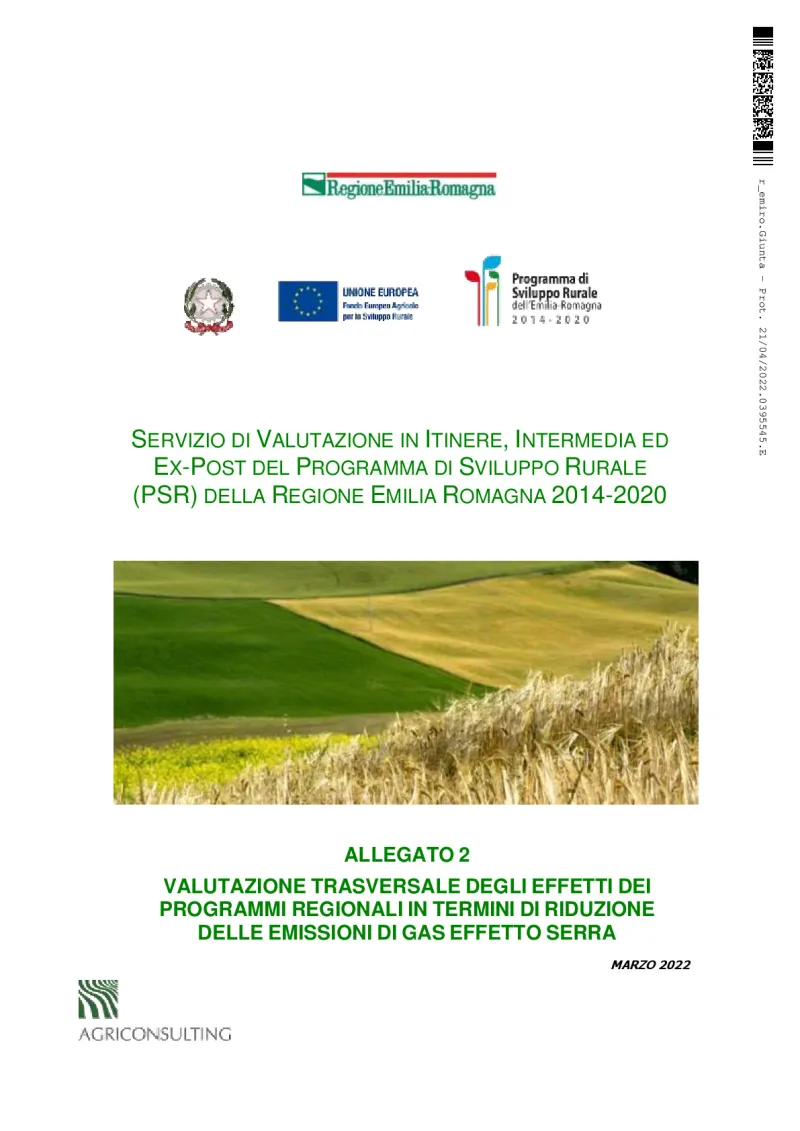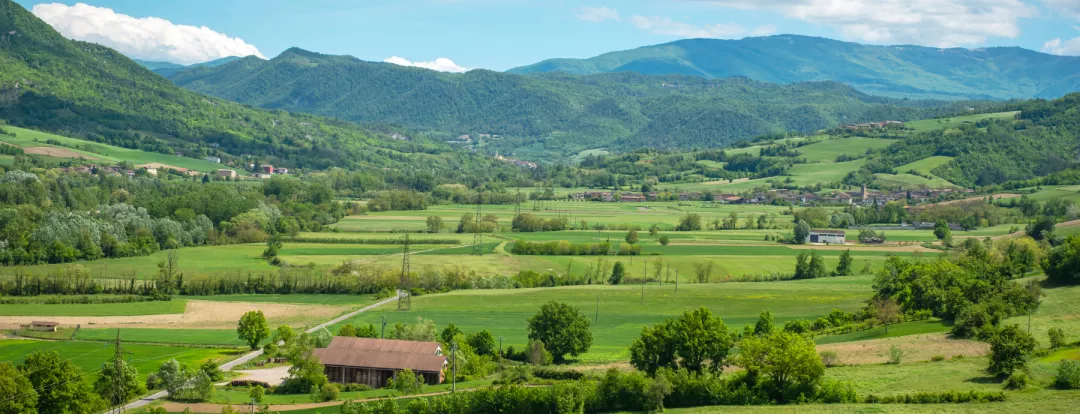Cross-cutting assessment of the effects of regional programmes in reducing greenhouse gas emissions
The evaluation analyses the contribution of the ESI Funds (ERDF, ESF and EAFRD) in reducing greenhouse gas emissions in the Emilia Romagna region of Italy.
- Italy
- 2014-2022
- Environmental impacts


The evaluation is carried out in the framework of the Emilia-Romagna region's 2014-2020 Rural Development Programme (RDP). It also comprises setting up and coordinating the cross-cutting assessment of the 'Environmental sustainability policies: Climate change' foreseen in the Emilia Romagna region's 'Unitary Assessment Plan', defined by the national plan 'PRUVER'. It covers the period 2017-2020.
The evaluation's scope is to analyse the European Structural and Investment Funds' (ERDF, ESF and EAFRD) contribution to reducing greenhouse gas (GHG) emissions in the Emilia Romagna region, which are among the main causes of climate change.
The evaluation examined the effects of the different interventions funded by the ESI regional programmes on climate change mitigation and adaptation.
The evaluation focuses on the effectiveness and efficiency evaluation criteria.
The evaluation is based on a quantitative approach. The quantification of the contribution to climate change mitigation, expressed as the reduction of GHG emissions (CO2-equivalent/CO2e), relies on the actions financed by the ERDF regional operational programme (ROP) and the RDP, based on the elements identified by their evaluators.
The analysis corresponds to 270 operations financed by 31 December 2020 related to the cross-cutting theme of climate change, involving 10 563 recipients.
Concerning the ROP, the potential reduction is quantified based on the interventions presenting a concession decree (i.e. financed but not yet concluded) as of 31/12/2020. In this case, indicators are derived from the regional monitoring system (i.e. energy indicators per financed project required in calls to estimate interventions' planned (or expected) impact).
In the case of the RDP, the GHG emissions reduction is quantified based on the projects completed by 31/12/2020. The indicators are derived from the regional monitoring system and supplemented by surveys carried out by the evaluator and a literature review.
CMEF indicators and programme-specific indicators are used (i.e. GHG emission reduction, public expenditure granted (EUR), annual public expenditure (EUR) and euro per tonne of CO2e reduced).
The report is structured into five evaluation questions and elaborates on the lessons learned from the evaluation of the 2014-2020 programming period.
The main limitation was estimating ESI funds' contribution to climate change mitigation because it was calculated differently than the analysed operational programmes:
- in the case of the ROP, the estimation of GHG reduction was conducted in a 'potential' way using the information derived from regional monitoring because of the low number of projects concluded by the time the evaluation was concluded;
- in the case of the RDP, quantification is carried out on concluded projects using data from surveys and regional monitoring.
Therefore, the quantification of the reduction of GHG emissions is measured using different methods and refers to different contexts, according to the operational programmes.
The evaluation quantifies that the annual GHG emissions reduction determined by the 2014-2020 ROP and RDP interventions amounts to more than 200 CO2e/year, of which 59% is quantified based on completed RDP interventions and 41% on ERDF interventions financed but not yet concluded (both as of 31/12/2020).
GHG emissions were prevented in the Emilia Romagna region thanks to ESI funds accounting for about 52% of increased emissions (+384.26 CO2e) in 2019 compared to the 1990 baseline. In the absence of ESI funds, the increase in emissions in 2019 compared to 1990 would have been 584.57 CO2e (+1.46%), but thanks to the contribution of the ROP and RDP the increase in emissions is limited to 0.96%.
The reduction determined by the ESI funds represents 2.5% of the Emilia Romagna region's objective of reducing 1990 emission levels by 20%, quantified at 8 012 CO2e.
The reduction of GHG determined by RDP interventions is 110 629 tonnes of CO2e per year, representing 3.4% of regional emissions of the agricultural sector, which was based on better management of manure on livestock farms, decreased nitrogen fertilisation on agricultural land, and carbon sequestration in soil and in forest biomass. Moreover, 6.62 CO2e is determined by the increased of energy production from renewable sources, which represents 0.63% of the regional electricity consumption in agriculture.
The evaluation also highlights that the actions implemented under the RDP and ROP are able to act simultaneously on the objectives of mitigation and the reduction of the risk generated by climate change. According to the evaluation, the actions under the two programmes aimed at energy production, eco-efficiency and reduction of fossil energy consumption contribute to reducing emissions and address the risks related to the increase in energy consumption. Moreover, RDP forestry measures contrast the risk of forest fires, hydrogeological instability and loss of biodiversity, and area measures are instrumental in counteracting soil degradation or desertification, reduced water availability and loss of biodiversity. Finally, investments in stables make it possible to cope with rising temperatures with positive effects on animal welfare and production capacity.
The evaluation concludes that the actions implemented by the Emilia Romagna region (both under the RDP and ERDF) for climate change mitigation and adaptation result in positive effects on other environmental variables, such as on air quality due to reduced combustion of fossil energy sources because of energy efficiency measures. Concerning RDP, the reduced use of nitrogen fertilisers financed in area-based measures not only leads to effects on climate change mitigation but also reduces ammonia emissions and the release of nitrates into water. Reducing ammonia emissions has a positive effect on air and water quality through the reduction of acidification and eutrophication, and contributes to maintaining ecosystems and biodiversity.
Finally, the evaluation found that the cost of emissions reduction (euro/CO2e) by ERDF interventions is EUR 59 per reduced tonne of CO2e, whereas the cost incurred by the RDP per tonne of CO2e reduced is EUR 149. The lower estimated efficiency of the RDP measures respects the efficiency of ERDF interventions and must take into account that the RDP measures had, in addition to GHG reduction, also the objective of reducing ammonia.
Author(s)
Agriconsulting